7 Vital Signs – When Do Border Collies Go Into Heat?
Many Border Collie owners are often curious about when their beloved canine companions go into heat. After all, understanding the heat cycle is essential for pet owners looking to breed their dogs or simply to ensure the optimal health and well-being of their furry friends. Border Collies, like all dogs, experience heat cycles that play a crucial role in their reproduction and overall health.
Border Collies typically experience their first heat cycle at around 6 months to 1 year of age. This time frame can vary depending on the individual dog’s genetics, size, and overall health. The heat cycle in Border Collies usually lasts between 2 to 4 weeks, with dogs entering the heat cycle roughly every 6 to 8 months.

It’s important to recognize the signs of a Border Collie in heat and understand how to properly care for your dog during this time to ensure their health and safety.
Key Takeaways
- Border Collies usually go into heat between 6 months and 1 year of age
- The heat cycle lasts 2 to 4 weeks and occurs every 6 to 8 months
- Understanding your Border Collie’s heat cycle is crucial for breeding and overall health maintenance
Border Collie Heat Cycle Overview
Border Collies, like all dogs, go through different stages in their heat cycles. The heat cycle, also known as the estrus cycle, is a recurring stage in a dog’s life where she becomes receptive to mating with males. So, let’s dive into the world of Border Collie heat cycles and shed some light on the subject, without getting “too hot”!
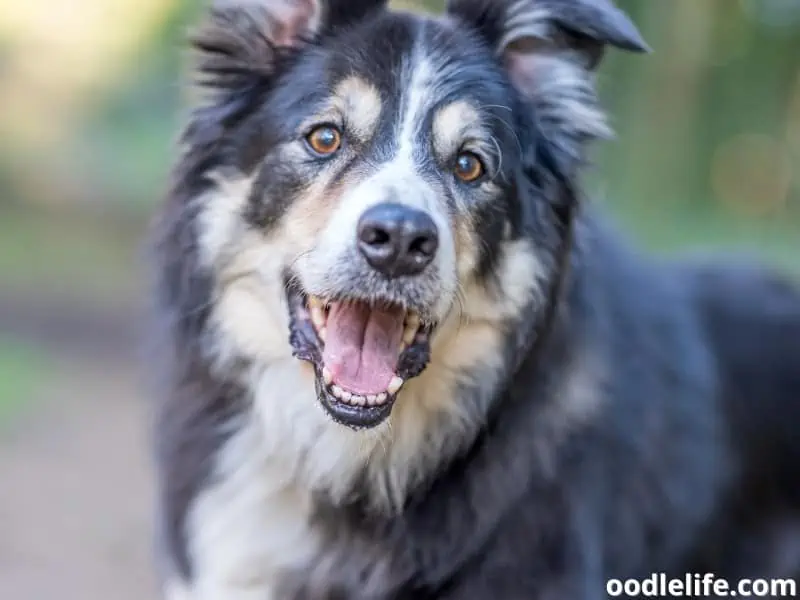
Frequency of Heat Cycles
Border Collies typically experience their first heat cycle around 6 to 12 months of age. After that, they generally have heat cycles every 6 to 9 months. However, this can vary depending on the individual dog, so you really can’t set your calendar by it.
It’s like waiting for a bus that’s never quite on schedule.
Stages of the Heat Cycle
There are four main stages in a Border Collie’s heat cycle. Don’t worry, we won’t get too scientific here, but it’s good to be aware of what’s going on with your furry friend.
Proestrus: This first stage is the start of it all. Your Border Collie might show some signs like swelling of the vulva and a bloody discharge. It’s Mother Nature’s way of saying, “Hey, something interesting is happening here!” Proestrus typically lasts 7 to 12 days.
Estrus: This is the main event when your Border Collie is actually in heat, meaning she is receptive to mating with males. The discharge may become lighter, and she may be more affectionate or “flirty” with other dogs. They don’t call it “puppy love” for nothing! This stage generally lasts around 5 to 9 days.
Diestrus: After the party is over, your Border Collie enters diestrus. This stage signifies the end of her heat cycle, and she’s no longer interested in male dogs. No more fun and games; it’s time to get back to herding sheep and catching frisbees. Diestrus can last for approximately 2 to 3 months.
Anestrus: The final stage, anestrus, is when your Border Collie is in reproductive “time-out.” She’s not in heat, and she won’t be for a while. This stage is like winter for Border Collies – a time to rest and recharge. Anestrus usually lasts for 4 to 5 months before the heat cycle starts again.
So, there you have it – a brief overview of the Border Collie heat cycle. Of course, every Border Collie is different, but at least now you know what to expect without breaking a sweat!
Signs Your Border Collie is in Heat
As a Border Collie owner, it’s essential to recognize when your furry friend is in heat. This information can come in handy, whether you’re planning on breeding your dog or just taking the necessary precautions during this time. Here are some physical and behavioral changes you might notice in your Border Collie when they’re in heat.
Physical Changes
One of the most noticeable physical changes during this time is a swollen vulva. This enlargement typically occurs just before the bleeding starts and lasts throughout the heat cycle. Another prominent sign is a bloody discharge.
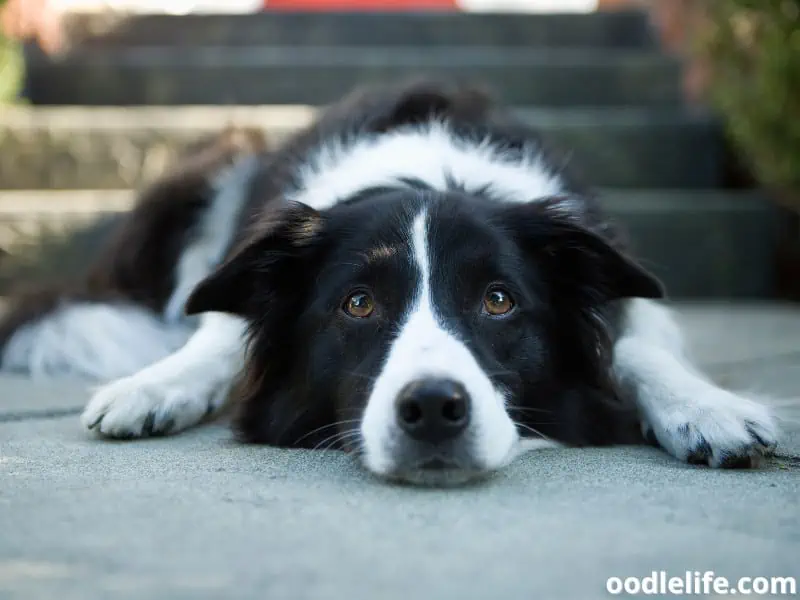
It usually begins as a bloody or reddish fluid and eventually turns light pink or clear as the cycle progresses.
You might also observe frequent urination during your Border Collie’s heat cycle. They might mark their territory more often than usual – and this isn’t just a fad, it’s their way of sending signals to potential mates. So don’t be surprised if your usually well-behaved pup suddenly starts “decorating” your yard or favorite walking spots.
Behavioral Changes
Border Collies can experience various behavioral changes while in heat. They might become more affectionate towards you and other animals in the household. Yes, that includes cuddling with the cat they’d otherwise chase around.
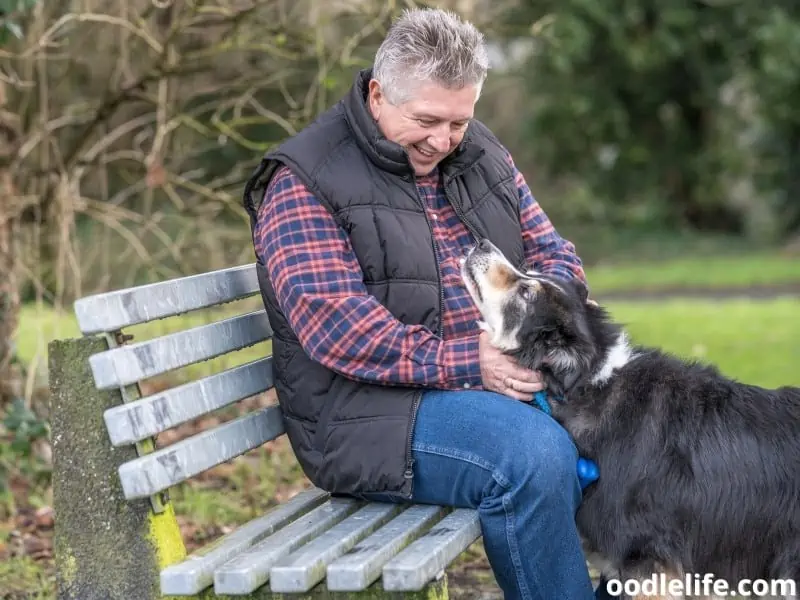
Keep an eye out for flagging, which involves lifting and moving their tail to one side to expose the vulva – an open invitation to potential mates.
Your otherwise calm and obedient Border Collie might seem more distracted. They’re not suddenly rebels without a cause; their hormones are causing quite the canine commotion. So don’t be too harsh on them for zoning out during an intense game of fetch.
One more thing, having your Border Collie in heat might turn your peaceful home into the hottest dog hangout on the block. Expect unscheduled visits from male dogs in the neighborhood – it’s like a canine version of “The Bachelor.”
Remember to keep your sense of humor and patience during this time. It’s just part and parcel of the Border Collie’s journey, and eventually, things will return to normal. Happy tail wagging!
Border Collie Age and First Heat
Border Collies are known for their agility, intelligence, and working ability, but they are also like any other breed when it comes to sexual maturity and experiencing their first heat. This section will offer insights into the average age of Border Collies at which they have their first heat and factors that can influence this timeline.
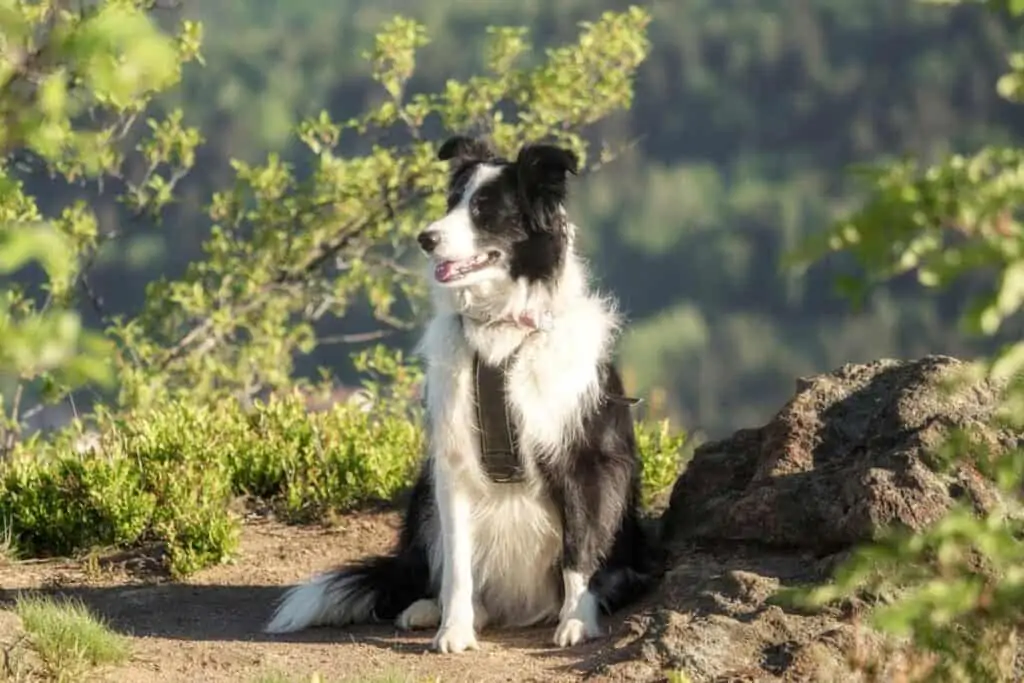
Average Age
Typically, a Border Collie will have her first heat cycle when she reaches sexual maturity, which usually occurs between 6 months to 1 year of age. However, it’s also normal for some dogs to have their first heat as late as 18 months. As with every dog breed, the age at which a Border Collie enters her first heat can differ for each individual pup.
It’s essential to monitor her and stay observant of any signs indicating that she’s coming into heat.
Some indications that your Border Collie is entering heat can include:
- Swelling around the vulvar region
- Occasional discharge or bloody spots
- Increased urination
- Changes in her behavior or mood
Remember, these signs may vary from dog to dog, so it’s important to stay vigilant and get to know your pet better to identify her unique patterns.
Factors Influencing the First Heat
Just as no two Border Collies are exactly the same, there are several factors that contribute to the age of when your dog will experience her first heat. These factors can include:
- Genetics: A Border Collie’s genes play a significant role in determining the age of first heat. Investigating the family history of your pup can provide valuable insights into the age of sexual maturity she may reach.
- Size: Smaller breeds tend to mature faster and go into heat earlier compared to larger dog breeds. While Border Collies usually fall in the medium category, their individual size may also impact their timing for the first heat.
- Nutrition: A well-balanced, high-quality diet positively affects a Border Collie’s overall health, including their growth and maturity. Good nutrition can lead to a more stable and predictable heat cycle.
- Environment: Stress in a dog’s living situation can delay or disturb her heat cycle. A calm and loving environment is beneficial for a Border Collie’s overall well-being.
In conclusion, stay observant of your Border Collie as she matures, and consult with your veterinarian for advice and insights if needed. After all, every dog’s experience and timeline may differ, so it’s essential to be well-informed about your own pet.
Caring for Your Border Collie in Heat
Environmental Comfort
When your Border Collie goes into heat, it’s essential to provide a comfortable environment for them. Make sure the space is clean, as they will be experiencing some discharge during this time. A soft bed with a washable cover is a great idea since you’ll want to keep their sleeping area clean and fresh, too.

One hot tip from experienced dog owners: climate control is crucial! Keep your home at a comfortable temperature, and don’t forget to provide a good balance of shade and sunlight for outdoor lounging. Remember, Border Collies can be a bit diva-ish when it comes to their environment… just like us!
Special Precautions and Attention
During their heat cycle, Border Collies may become a bit more clingy or sensitive. Offer some extra affection (within reason) to help them feel loved and comfortable. It’s also important to keep an eye on them when they’re outside, as other dogs may be attracted by their scent.
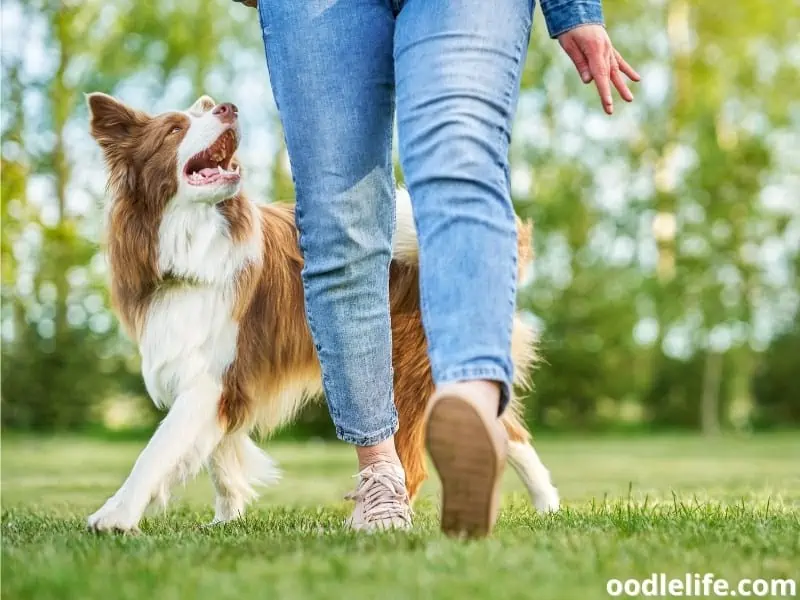
In addition, you’ll want to avoid taking your dog to places where they may interact with unneutered male dogs. Stick to solo walks or doggy play-dates with well-known canine friends to prevent any unwanted romantic encounters.
Diet and Exercise
Although it might seem counterintuitive, it’s essential to maintain a consistent exercise routine during your Border Collie’s heat cycle. Gentle walks and activities can help reduce their anxiety and ensure they’re staying fit. Avoid overly strenuous exercises or those that involve jumping or twisting, as these can cause discomfort during this time.
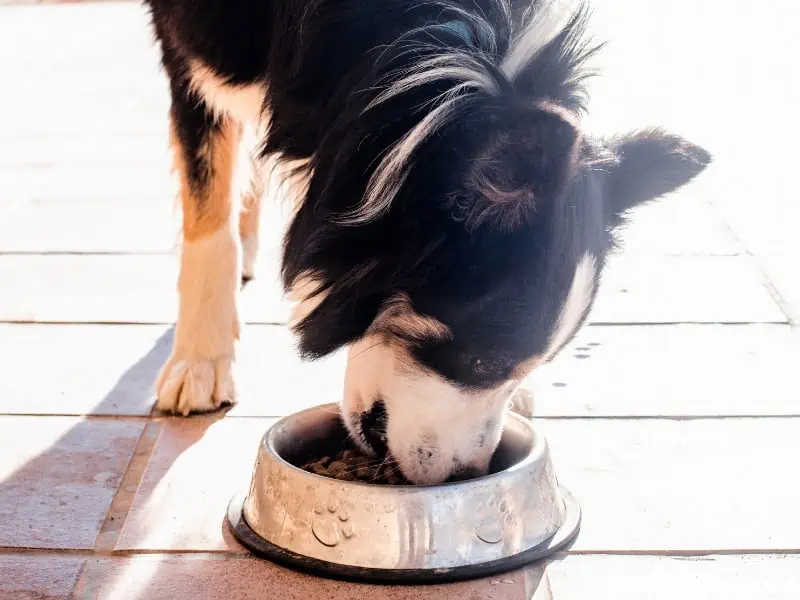
As for their diet, there’s no need for any drastic changes—but do offer them healthy treats to keep them happy. Just remember not to spoil them too much; you don’t want a diva dog with a refined palate demanding truffle-infused biscuits, do you?
In conclusion, caring for your Border Collie in heat can be a breeze if you remember to focus on their comfort, take special precautions, and maintain a consistent diet and exercise routine. With a bit of TLC, you’ll be able to navigate this phase of your dog’s life with ease—no drama, no fuss, just one happy pupper!
Breeding and Pregnancy Considerations
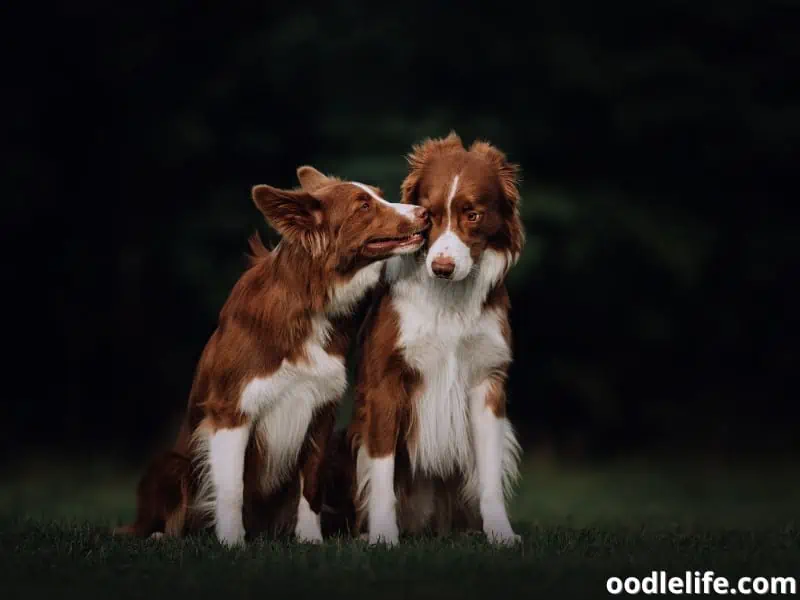
Deciding to Breed
When deciding to breed your Border Collie, it’s essential to consider the health and well-being of both the male and female dogs involved. Ensure that both dogs are healthy, free of any genetic conditions, and have been screened for common issues in the breed, such as hip dysplasia. Consult with a veterinarian to assess the overall health of each dog before deciding to breed them.
Breeding Border Collies should also be done responsibly and with purpose. Reputable breeders aim to preserve and improve the breed by only breeding healthy and temperamentally sound dogs. Remember, life is ruff, and we want the best for these pups!
Male Dogs and Mating
Ah, the joys of adolescence. As male Border Collies mature, they may start exhibiting behaviors associated with being in heat, such as marking and seeking female dogs. Being able to identify these behaviors is essential for responsible breeding practices and ensuring that both dogs are ready and consent to the process.
To minimize stress and maintain a sense of propriety, male and female dogs should be introduced in a controlled environment with supervision. This will allow both dogs to become acquainted and ensure a safe and successful mating process. And who knows, they might end up being best furriends!
Unwanted Pregnancies Prevention
An essential, yet often overlooked aspect of responsible dog ownership, is the prevention of unwanted pregnancies. For pet owners who do not wish to breed their Border Collies, options include spaying female dogs (removing ovaries) or neutering male dogs.
Using fences, crates or designated areas within your home can also help keep your curious male Border Collie away from females in heat. Inform your neighbors if you have an unspayed female dog experiencing her mating cycle to avoid any unexpected visitors. Like that one nosy neighbor, it’s always better to prevent rather than deal with the consequences later.
In conclusion, being a responsible Border Collie breeder extends beyond simply loving these dogs. It involves careful breeding practices, understanding the needs of both male and female dogs, and preventing unwanted pregnancies. Making these considerations will not only result in healthier litters but also contribute to a stronger and flourishing breed.
Health Issues and Spaying
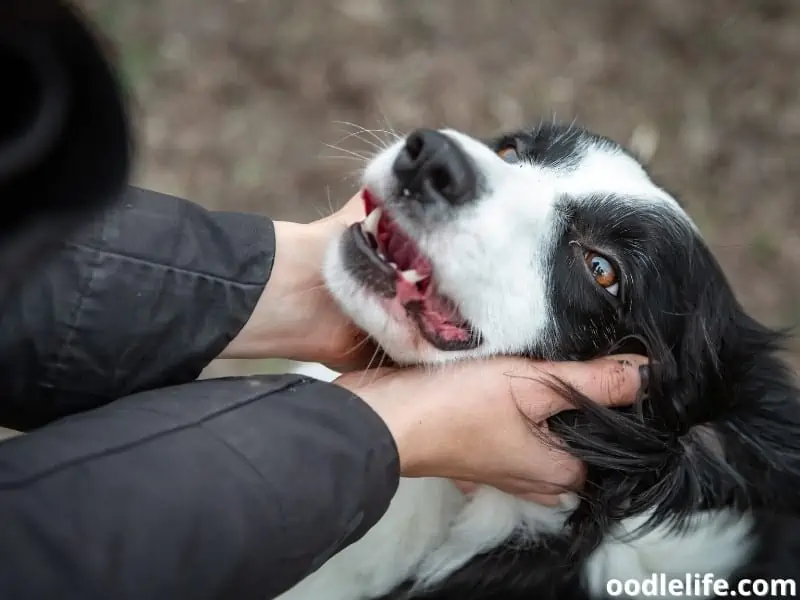
Potential Health Risks
Border Collies, just like any other dog breed, can potentially face some health risks. One of the common health issues that may be associated with the heat cycle is pyometra, a serious infection of the uterus that can occur in unspayed females. Moreover, these intelligent dogs may also be prone to specific conditions like epilepsy or Border Collie collapse, which can affect their energy levels and overall fitness.
On a lighter note, here’s an analogy – it’s like humans needing to take extra care of their bodies as they age, and monitor risks for diseases. Keeping an eye on your Border Collie’s health helps ensure they can stay as energetic as possible.
Benefits of Spaying
Spaying a Border Collie offers a plethora of benefits, such as:
- Preventing the development of pyometra (remember that pesky uterine infection we mentioned earlier?)
- Reducing the likelihood of mammary tumors
- Avoiding unwanted pregnancies (let’s face it, puppies are adorable, but not everyone is prepared to handle an unexpected litter!)
- Making the heat cycle and its associated behaviors (like messiness and moodiness) a thing of the past
Overall, spaying contributes to a happier and healthier life for a female Border Collie. Just like when people decide to remove wisdom teeth to avoid future complications – it’s a proactive choice for your furry friend’s wellbeing.
Choosing the Right Time to Spay
When should you spay your Border Collie? Now that is the question! It’s typically recommended to consult with your trusted veterinarian to determine the best timing based on your dog’s size, energy levels, and specific needs. Generally, spaying is performed on dogs between 6 months and 1 year of age, but there can be exceptions depending on each individual case.
Choosing the right time to spay can vary, just like how people handle important milestones differently. It is essential to weigh the benefits and potential risks, guided by expert advice, to make the best decision for your Border Collie. No matter what you choose, keeping your dog’s health in check is a top priority – after all, they are our beloved companions who deserve the best care!
Frequently Asked Questions
At what age do Border Collies typically experience their first heat?
Border Collies typically experience their first heat cycle between 6 and 12 months of age. However, this can vary between individual dogs, with some entering heat as early as 5 months or as late as 14 months. It’s important to keep an eye on your dog’s behavior and physical changes to recognize when she enters her first heat.
What are common signs of a Border Collie in heat?
Common signs of a Border Collie in heat include swelling of the vulva, frequent urination, and bloody discharge. Your dog may also exhibit behavioral changes such as increased affection or agitation, decreased appetite, and frequent licking of the genital area. She might also initiate “flagging,” where she raises her tail to invite other dogs for mating.
How long does a heat cycle last for a Border Collie?
A heat cycle lasts for about 21 days in a Border Collie, with the most fertile period typically occurring between days 9 to 14. Keep in mind, these numbers may vary between individual dogs, and it’s important to monitor your dog closely to understand her unique cycle.
How often do Border Collies experience heat cycles?
Border Collies experience heat cycles about every six months, but the frequency can vary from dog to dog. Some may have more irregular cycles, with intervals ranging anywhere from four to 12 months. It’s crucial to observe your dog’s behavior and physical changes to recognize her individual cycle pattern.
How long do female Border Collies bleed during heat?
During the heat cycle, bleeding usually lasts for one to two weeks. This can vary between dogs, so it’s important to keep an eye on your Border Collie to help determine her specific duration. Remember to be patient and provide a clean and comfortable environment for your dog during this time.
Are there any differences in the first heat for a Border Collie?
The first heat cycle for a Border Collie may be shorter or less intense than subsequent cycles. You may also notice more irregularities in the cycle duration or the interval between cycles. With time, your dog’s body will mature, and her cycles will generally become more consistent and easier to predict.
So, sit back and enjoy the rollercoaster ride of your Border Collie’s adolescence!